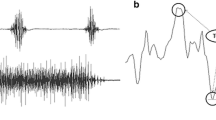Abstract
Six male volunteers assumed either “relaxed” or “unrelaxed” postures, as defined by a Behavioral Relaxation Scale, in seven areas of the body. Electromyographic (EMG) levels in the muscle groups associated with each area were determined for both categories of postures. In all instances, the “relaxed” postures produced significantly lower EMG levels than the “unrelaxed” postures. This indicates that the Behavioral Relaxation Scale is a valid behavioral measure of relaxation. Also, it supports other studies which have shown that direct training in emitting relaxed postures is an effective means of achieving relaxation.
Similar content being viewed by others
Reference notes
Schilling, D. J., & Poppen, R. Behavioral and EMG feedback in relaxation. Presented at the annual meeting of the Biofeedback Society of America, March, 1981, Louisville, Ky.
Schilling, D. J., & Poppen, R. Behavioral relaxation training and assessment. Submitted.
References
Benson, H.The relaxation response. New York: Wm. Morrow, 1975.
Bernstein, D. A., & Borkovec, T. D.Progressive relaxation training: A manual for the helping professions. Chicago: Research Press, 1973.
Jacobson, E.Progressive relaxation. Chicago: University of Chicago Press, 1938.
Luiselli, J. K. Relaxation training with the developmentally disabled: A reappraisal.Behavior Research of Severe Developmental Disabilities 1980,1 191–213.
Luiselli, J. K., Marholin, K., II, Steinman, D. L., & Steinman, W. Assessing the effects of relaxation training.Behavior Therapy 1979,10 663–668.
Mathews, A. M. Psychophysiological approaches to the investigation of desensitization and related procedures.Psychological Bulletin 1971,76 73–91.
Tarler-Benlolo, L. The role of relaxation in biofeedback training: A critical review of the literature.Psychological Bulletin 1978,85 727–755.
Wolpe, J.The practice of behavior therapy. (2nd Ed.). Oxford: Pergamon, 1973.
Author information
Authors and Affiliations
Additional information
This study was conducted in partial fulfillment of the M.A. degree by Jerry P. Maurer. Appreciation is expressed to Tz-Yi Jiang, Dr. Robert Lehr, and Jim Rice for their assistance.
Rights and permissions
About this article
Cite this article
Poppen, R., Maurer, J.P. Electromyographic analysis of relaxed postures. Biofeedback and Self-Regulation 7, 491–498 (1982). https://doi.org/10.1007/BF00998889
Issue Date:
DOI: https://doi.org/10.1007/BF00998889




